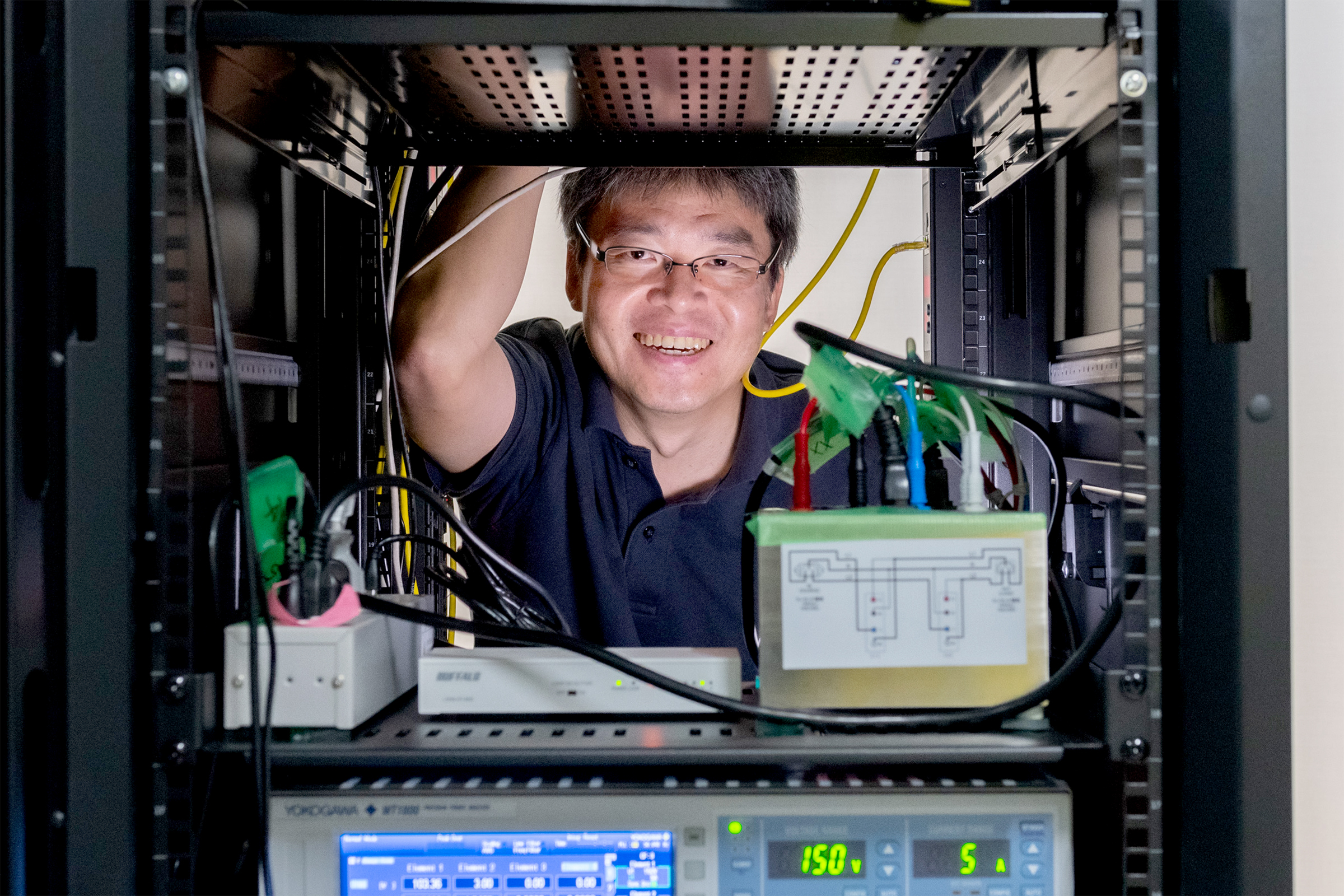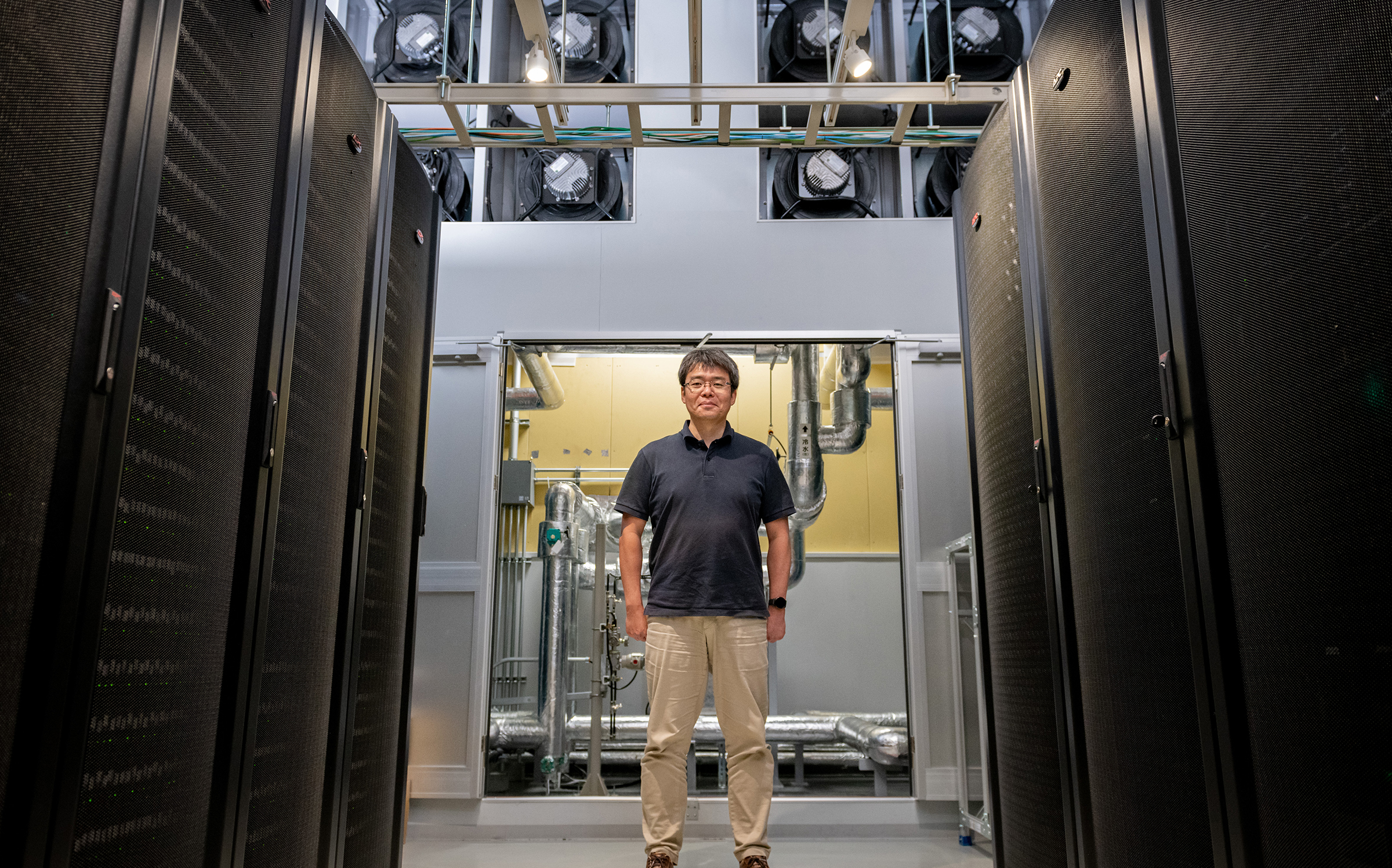Making computers faster at their core
Pursuing the extreme end of system software to pioneer new possibilities for computers

Typically speaking, computers use a combination of hardware and software to operate. Connecting these two elements is the system software. System software is an unseen element that supports the computer at its core. Professor Kazuo Goda, of Institute of Industrial Science, The University of Tokyo, considers himself a computer lover down to his very core. Over his many years working with computers, Goda found himself drawn to the workings of system software, and has dedicated himself to research activities in that field. System software developed by Goda today serves a major role in various fields, including health care and social infrastructure. We spoke with Goda about how system software operates and what he sees as the future of computers.
“I want to explore the possibilities at the core of computers”
Professor Kazuo Goda considered himself a computer geek as a kid. From a young age, he was always curious about what it was that made computers work.
“The “Famicom” console was very popular when I was a child. However, more than playing games, I was curious as to why pressing a key to the right would cause Super Mario to move in that direction. I eventually grew this desire to understand how these things worked and to be able to recreate them myself.”
During that period, Goda taught himself programming and learned to create games. He even opened up and modified a computer he received from a relative. As a university student, he earned tuition money by creating and selling application software for company business management and e-commerce, which was gaining popularity around that time. Over time, his desire to pursue the core possibilities of computers intensified. In graduate school, this desire led Goda to begin researching system software, the figurative core of a computer.
“Generally speaking, computers are comprised of hardware and software (applications). Hardware works based on physical properties while software operates based on logic. Connecting these two elements is the system software. When you read that code, you can gain a full understanding of the mechanism behind why pressing the keyboard causes the screen display to change. Knowing this gives you the feeling that you are understanding computers. That was a pleasant feeling for me, and inspired me to delve further into system software research.”
In graduate school, Goda went on research Electrical and Electronic Engineering at The University of Tokyo School of Engineering, where he was mentored by Professor Masaru Kitsuregawa at UTokyo-IIS. As Professor Kitsuregawa was a specialist in databases, this meant choosing a field of specialization in system software used for large-scale data (database systems and storage systems). Currently, Goda is engaged in research centered on three points: providing the system software handling data overwhelming speed while reducing energy consumption, and making it easier to use.
Making it possible to maximize hardware performance
When you make an improvement to system software, what specific change does this cause in the computer? Goda provided a case study involving purchasing records analysis for an online shop.
“With online shops, say, for example, there are 60 billion sets of data concerning who purchased what and when. Think about using that data to analyze changes between last year and this year in purchasing trends among women in their 20s. Using a current standard database system to conduct this analysis would take approximately 20 minutes for data processing. However, using the system we developed, this analysis can be completed in 10 seconds.”
What changed was the speed at which data is accessed. This speed has been increased by nearly 100-fold, making the processing time that much faster. Normally, only a fraction of the computer hardware’s processing capability is used, even when that capability is very high. This is because the hardware is not equipped with system software capable of sufficiently maximizing the physical potential of the hardware. In most cases, the computer’s processing speed is still sufficiently fast, so there hasn’t been much demand for optimizing system software. However, in cases like this when working with big data, that difference can become a bottleneck. Altering the database system algorithms to better suit the hardware makes it possible to access data at speeds representing nearly 100% of the hardware’s capabilities. This results in a significantly increase in processing speed. Of course, making such modifications to system software is very difficult. It requires a complete understanding of computers, including the hardware, operating systems, and the various software being used.
“There was not much momentum for the idea of fundamentally reevaluating system software to make computers faster. However, data is likely to continue growing moving forward, and I believe this will make the algorithms we created more important.”
In systems used by local municipalities
The technology developed at Goda’s lab is actually in use within society. One example of adoption can be seen in the Japanese health care domain.
“For example, the Ministry of Health, Labour and Welfare of Japan (MHLW) gathers medical insurance claim data submitted by medical institutions nationwide. The MHLW created a research group to analyze this data for the purpose of improving Japan’s health care. However, at the time, this data was massive and comprised some 200 billion data sets. Even if medical professors had a desire to analyze how medical expenses were used, it would take anywhere from several days to two weeks. As a solution, we were tasked with applying our technology towards building a high-speed platform for data analysis. While processing times differ depending on the type of analysis, we made it possible for a single analysis to be completed in a few minutes. As this is sensitive data, analysis could only be conducted within UTokyo-IIS security room. Even still, analysis could be conducted at speeds much faster than previously. This made the work itself enjoyable and led to some professors proactively participate in the project, making the trip to UTokyo-IIS numerous times to delve into their research.”
Reducing calculation times also made it possible to conduct analysis using data for every person who received medical care in Japan. This made it possible to identify the problem of the unnecessary prescribing of antibiotics, which helped raise new questions. This later led to an increase in local municipalities and researchers seeking to use the system created by Goda’s team. So much so that, today, over 100 cities, towns, and villages, use the system. One use case is a remote municipality lacking in medical resources. This municipality used the system to analyze the most appropriate locations to distribute medical resources.
“As someone whose greatest motivation in my research is my love for computers, I must admit that a part of me would like to end my work at a point where I can say, ‘computers have gotten this much faster!’ However, I also want to bring happiness to others through my work, so there is a sense of satisfaction in seeing the systems I create being implemented in society. The use of these systems leads to the discovery of new issues, which I hope will in turn drive the need to create even better systems.”
The future is the computer whose presence is not felt
Computers will continue to get faster, and the scope of the data they process will continue to get larger. Moving forward, where are computers headed? Goda says that, eventually, computers will reach a point where they require no human labor and you don’t notice their existence.
Over the past 30 years, the computer has changed the state of the world dramatically but, in principle, the role of the computer has remained unchanged: to increase productivity. Moving forward, this basic utilization will stay the same even as AI advances. For example, 30 years from now, AI will likely drive productivity to levels that are unimaginable by today’s standards. While there’s no competing in quantity, providing high-quality work, for example, producing disruptive ideas, is something that will require human thinking, and is not likely something that will be done by computers.
At the same time, Goda states that using computers to improve productivity actually requires massive amounts of human labor and energy. In other words, significant human labor is used for managing computers and keeping them running. Also, the required energy, in the form of electricity, is also massive. However, it is not the case that computer productivity will continue to rise indefinitely. We will reach that limit at some point in time and, when we do, notes Goda, the losses associated with the energy spent by humans will begin to garner attention.
“Who knows how many decades from now that is. However, when that does occur, I think computers will begin to shift in a direction that does not require human labor. Not dependent on human labor or energy, their presence will not be felt, but they will still support human lifestyle. As a person who loves computers, I feel a sense of sadness when I think that, someday, people will become unaware of computers and they won’t need our labor; like how a parent feels when their child moves away from home. That is the future I envision.”

A crowded server room. In the background is a massive energy-efficient air conditioning unit used to manage the environment inside the server room.




Comments
No comments yet.
Join by voting
How did you feel about the "Possible Future" depicted in this article? Vote on your expectations!
Please visit the laboratory website if you would like to learn more about this article.
Share